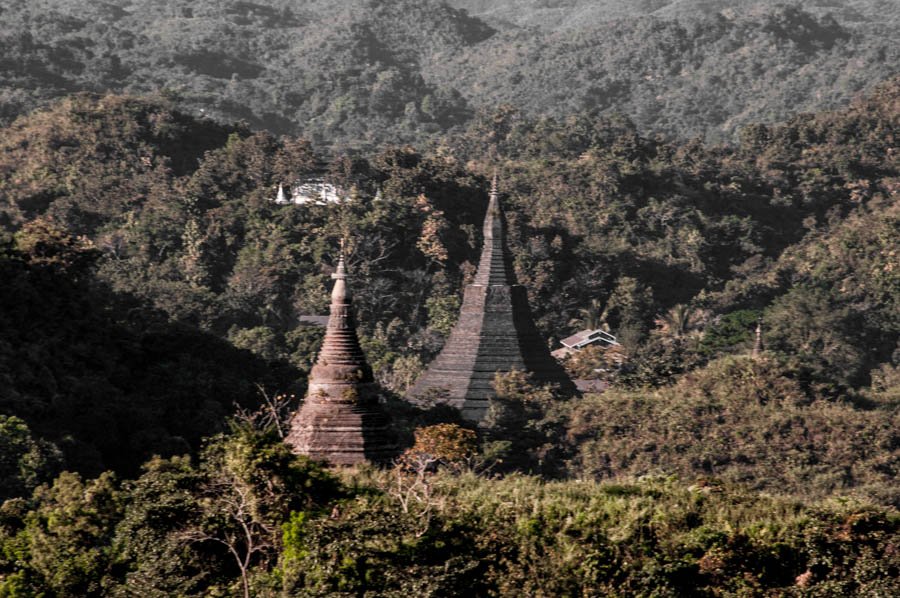I am organizing my posts about the Buddhist shrines and temples in the same way that Dr. Gutman did in her book, by the three major phases of the Mrauk U kingdom, which lasted from 1430 until 1784, when Bodawpaya captured the Mahamuni image and brought it (if it actually made it) to his new capital in Mandalay.
The oldest monuments that I took photos of and that is well covered in books about Mrauk U is the Pizi-Phara (or Pisie Buddha). Also called the Testes Relic Pagoda because it enshrines the pisie relic of the Buddha, Pizi Phara was installed by King Kawlia in the mid-12th century during the Pyinsa dynasty. It is located on the road between Pyinsa and Mrauk U. There is a view of Koe-taung Temple.
Pizi-Phara
The Pizi Buddha displays a serene Theravada style face, which looks more human and so is accessible to pilgrims. The head is larger in proportion to the body. This is an example of the later Pagan style also being squat with an elongated usnisa (top knot). Again the head is large in proportion to the body, with a wide chest narrowing toward hips. Buddha’s facial expression is more benign here, though, than early (ethereal) Pagan style.
The hill below this image was excavated in the 16th century during the Mrauk U kingdom, by King Min Phalaung. He installed four Buddha images in a round shrine. During this period, also, images were beginning to get crowned and ornamented as royalty. This first appeared in Pala art in Bengal. It was introduced to Pagan in the 11th century and other parts of Southeast Asia.
Royal Ornamentation
The royal ornamentation was mostly done by laypeople looking to acquire merit, which is still alive and well in Myanmar today. It worked back in the 16th century for both Theravada and Mahayana Buddhists. Concepts of royalty initially resulted from the Mahayana concept of combining in one image both the earthly form of the Buddha Sakayamuni and his heavenly form of Buddha Maitreya adorned by royal ornaments. In Theravada Buddhism, Sakyamuni takes on attributes of cakravartin, or the ideal world ruler.
Mrauk U Kingdom – The Three Phases
Firstly, we have the appropriately named First Phase, beginning in 1430, lasting until 1531, when Min Bin came to power. The temples and shrines included in this first phase include Le-Myet-Hna, Nyi-Daw, Mahabodhi Shwe-Gu, Htupayon, and Nibbuza, After this is the Middle Phase, beginning in 1531 and ending around 1600, only 70 years later. The temples built during this great and prolific period include Shit-taung, Koe-taung, Andaw-thein, Htu-kan-thein, Phara Ouk Pagoda, Pitaka Taik (library).
And, finally, the Late Phase begins where the Middle Phase left off and lasts until 1784 when the Mrauk U Kingdom was conquered. The Late Phase temples, monasteries and shrines include here Laung Pan-Prauk, Ratana-Pon, Mingala Manaung, Sakya Manaung and Mon-Kong Shwetu Pagoda were installed during this phase. These are all temples, shrines and monuments we visited during our week in Mrauk U in November, 2011. [Pamela Gutman, Burma’s Lost Kingdoms, 2001]
